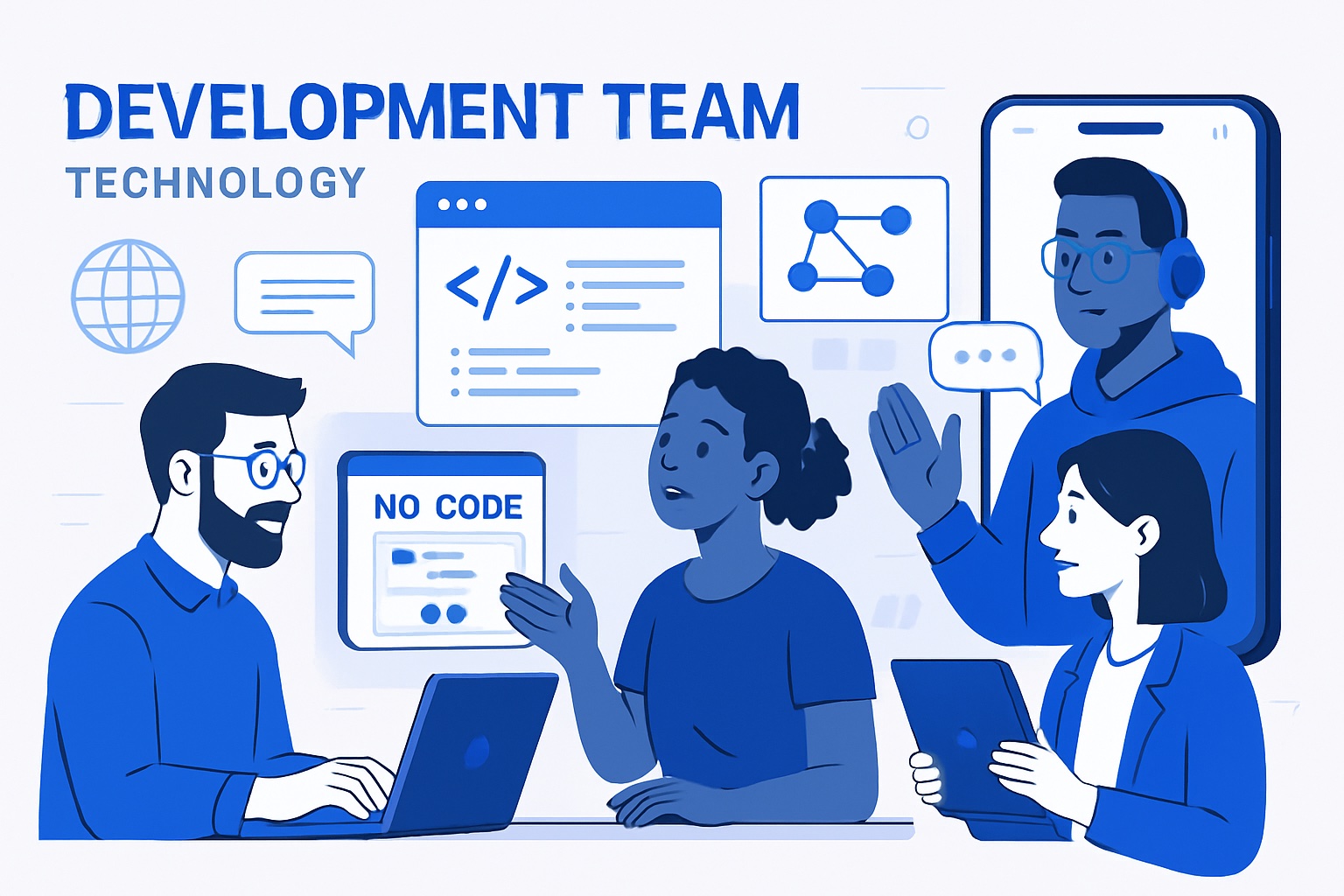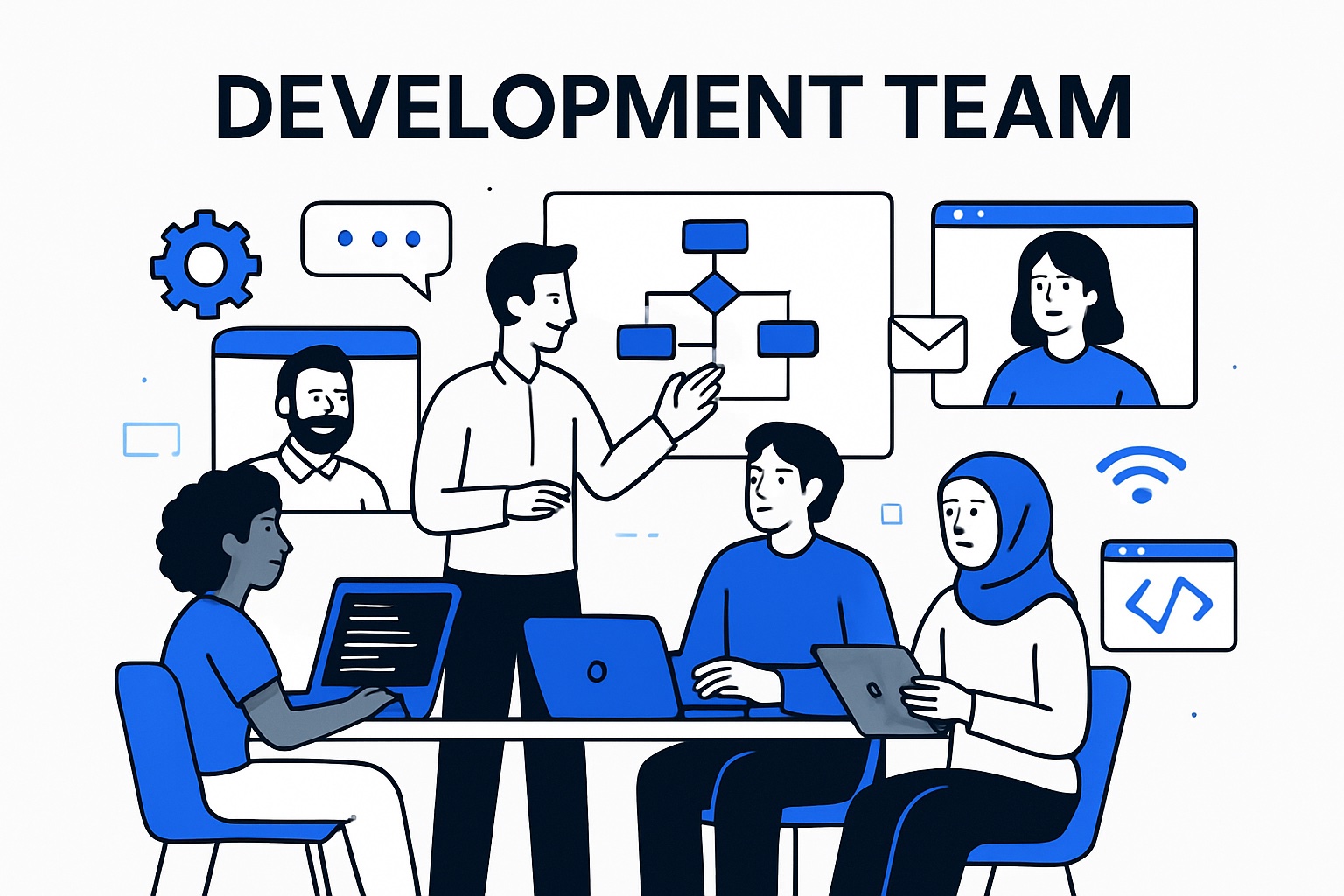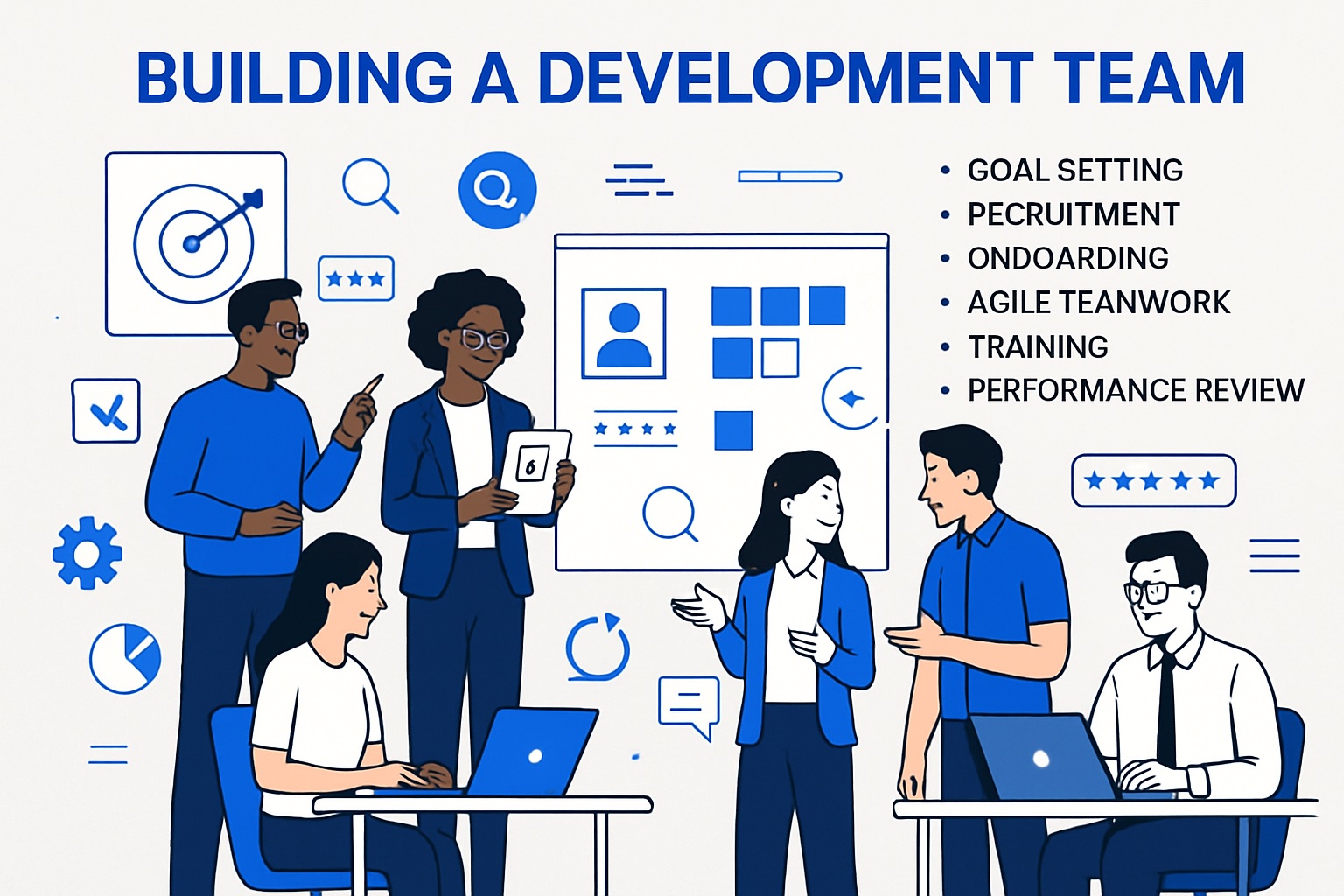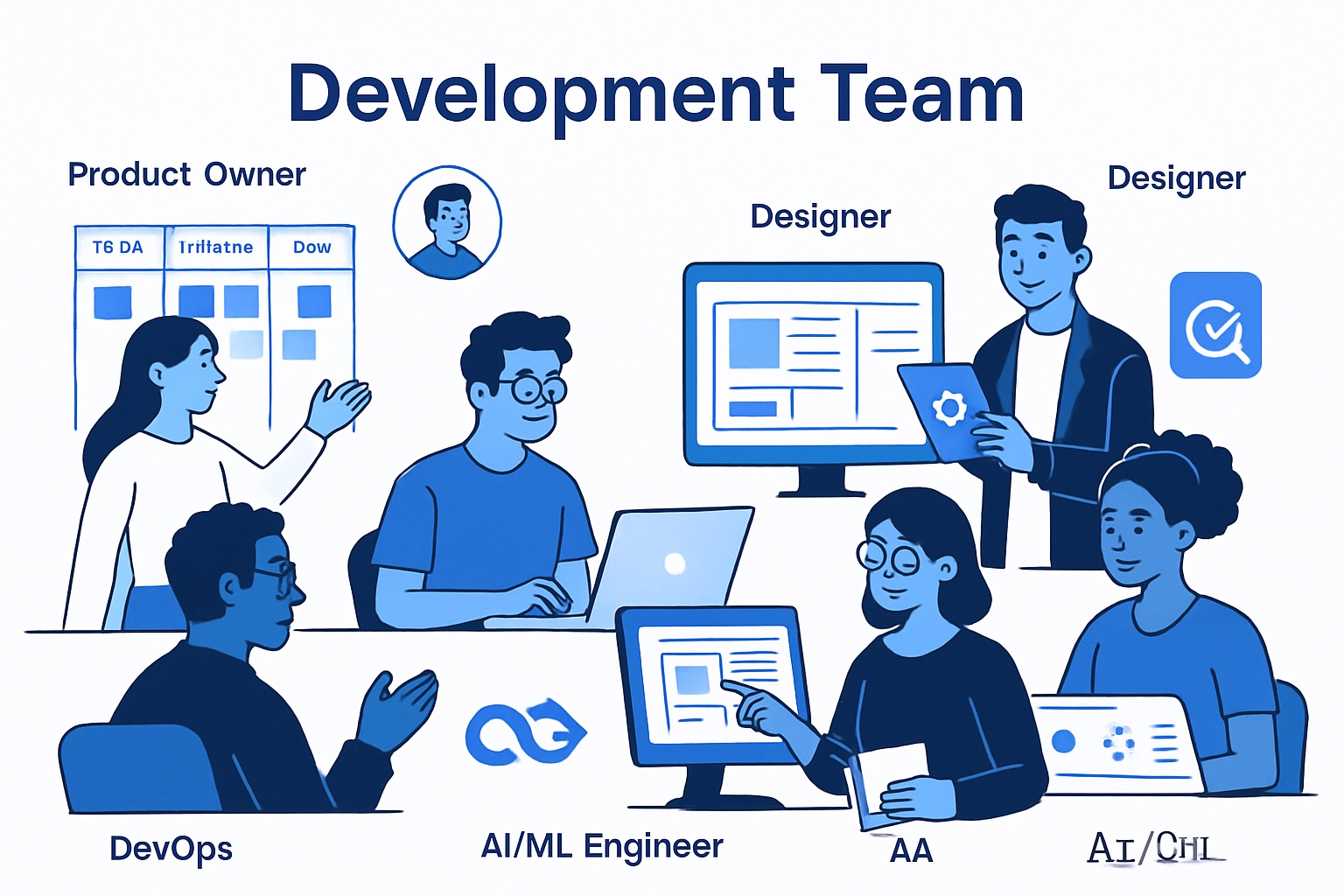In 2025, the pace of change in software is relentless. Success hinges on assembling the right development team—one that’s agile, skilled, and primed for innovation.
Businesses now face fierce competition and ever-shifting technologies. Only teams that adapt quickly and collaborate effectively can deliver standout digital products.
This guide provides a roadmap for building, structuring, and empowering a development team ready to thrive in today’s landscape. Discover proven strategies, essential roles, and emerging trends that set high-performing teams apart. Learn actionable steps and expert insights to help you assemble your ideal team for 2025 and beyond.
The Evolution of Development Teams in 2025
The evolution of the development team in 2025 is reshaping how organizations build, deploy, and maintain software. Rapid advances in technology, shifting work models, and new methodologies are redefining what it means to be a high-performing development team. Let’s explore the trends, challenges, and opportunities shaping the modern landscape.
Shifting Industry Trends and Technologies
The modern development team thrives in an era where remote and hybrid work models have become the norm. Teams now span continents, collaborating across time zones and cultures. This shift is driving companies to invest in robust digital collaboration tools and new communication strategies.
No-code and low-code platforms are rapidly gaining traction, enabling even non-developers to contribute to software projects. The adoption of AI-powered development tools is accelerating, with 2024 seeing a 30% increase in companies using AI-assisted coding. These technologies empower the development team to move faster and focus on higher-level problem-solving. For more on how these tools are transforming workflows, see No-code solutions for software development.
Cross-functional and multidisciplinary teams are now essential, blending skills from design, engineering, and analytics. Cloud-native architectures and DevOps practices are standard, supporting agile, iterative workflows. Continuous learning and upskilling are prioritized, helping every development team stay ahead in a fast-moving landscape.
Key Challenges Facing Modern Teams
Despite the advantages, today’s development team faces significant challenges. Managing distributed teams brings complexities in scheduling, communication, and cultural alignment. Teams must find ways to stay connected and productive, even when working asynchronously.
Balancing speed-to-market with code quality and security is another major hurdle. Rapid delivery can sometimes compromise testing and security protocols. Talent shortages and high turnover in tech roles add pressure, making it tough to build a stable development team.
Effective communication is critical. A 2024 survey found that 60% of CTOs ranked communication as their top challenge for remote teams. Without clear, transparent processes, misunderstandings and delays can derail progress. The development team needs frameworks and tools that foster clarity and collaboration at every stage.
Opportunities for Innovation
Amid these challenges, there are exciting opportunities for every development team willing to innovate. Automation and AI can streamline repetitive tasks, freeing up engineers to focus on creative problem-solving. Integrating customer feedback loops directly into the development process ensures products stay user-centric and relevant.
Collaborative platforms now bridge the gap between technical and non-technical stakeholders, making it easier to align on goals and priorities. Hybrid teams—blending in-person and remote members—are reporting a 25% boost in project delivery speed, according to recent case studies.
By embracing these opportunities, the modern development team is better equipped to adapt, iterate, and deliver high-quality software. Successful teams are those that leverage technology, foster open communication, and continuously evolve their skills and processes.
Core Roles and Responsibilities in a High-Performing Development Team
Building a successful development team in 2025 means assembling a group with the right mix of skills, adaptability, and shared vision. The core roles within a development team have evolved, reflecting the fast pace of technological change and the need for multidisciplinary expertise. Let’s break down the most crucial roles, the rise of specialized skills, collaboration habits, and how to strike the perfect team balance.

Essential Team Roles
A high-performing development team relies on a set of core roles. Each one brings unique expertise to the table, ensuring the product’s quality and timely delivery.
Key roles in a development team:
- Product Owner: Acts as the bridge between stakeholders and the technical team. Defines the vision and priorities, ensuring the final product aligns with user needs.
- Project Manager/Scrum Master: Keeps the project on track by managing timelines, resources, and communication. Facilitates agile ceremonies and removes obstacles for the team.
- Software Architect: Designs the system’s structure, making sure it’s scalable, secure, and maintainable in the long run.
- Developers (Frontend, Backend, Full-Stack): Write, test, and maintain the codebase. Their collaboration is central to a productive development team.
- UI/UX Designers: Craft user interfaces that are intuitive, accessible, and visually appealing, keeping the end-user experience front and center.
- QA/Test Engineers: Safeguard product quality through rigorous testing, automation, and bug tracking.
- DevOps Engineers: Streamline deployment, manage CI/CD pipelines, and ensure system reliability.
The synergy between these roles is what gives a development team its competitive edge. When each member understands their responsibilities, projects run smoother and outcomes improve.
Evolving and Specialized Roles
The modern development team is more diverse than ever, with new roles emerging to meet complex challenges. In 2024, 40% of teams introduced AI specialists, showing just how rapidly skills requirements are shifting.
Specialized roles transforming the development team:
- AI/ML Engineers: Bring intelligent automation and machine learning capabilities into products, helping teams innovate faster.
- Security Specialists: Address rising cybersecurity threats, ensuring compliance and robust data protection.
- Data Analysts/Engineers: Provide insights for data-driven decisions, integrating analytics into the product roadmap.
These evolving roles help a development team adapt to emerging tech trends and industry demands. By investing in specialized expertise, organizations can tackle challenges like automation, security, and big data head-on.
Collaboration and Role Overlap
Modern development teams thrive on collaboration and flexible skill sets. The days of rigid silos are fading, replaced by cross-functional teams where knowledge sharing is the norm.
Benefits of cross-functional development team structures:
- T-shaped team members: Individuals with deep expertise in one area and broad knowledge across others. This allows for better problem-solving and adaptability.
- Knowledge sharing: Reduces bottlenecks and prevents information from getting stuck in one person’s head.
- Hybrid teams: Combining generalists and specialists leads to faster delivery and improved adaptability. For example, hybrid teams routinely outperform traditional siloed teams in both speed and flexibility.
By encouraging collaboration and role overlap, a development team becomes more resilient and better equipped to handle shifting project needs.
Building the Right Mix
Assembling the optimal development team starts with a careful assessment of your project’s requirements. The right balance of specialists and generalists ensures both depth and flexibility.
Considerations for structuring your development team:
- Project needs: Complex projects benefit from specialists, while smaller, fast-moving initiatives may thrive with generalists.
- Hybrid teams: These offer the best of both worlds, enabling scalability and adaptability as priorities shift.
- Continuous evaluation: Regularly review your team’s composition and skill sets to ensure alignment with goals and tech trends.
For more insights and actionable tips on structuring your development team, check out these essential tips for software and development.
Ultimately, the most effective development team is one that can evolve, collaborate, and deliver high-quality products, no matter how the technology landscape changes.
Structuring Your Development Team for Success
The way you structure your development team can make or break your project’s outcome in 2025. With technology advancing quickly and business goals shifting, choosing the right mix of skills and processes is essential. Let’s explore how you can organize your team for maximum impact.

Team Types and Their Strengths
Every development team has unique strengths, depending on its structure. Specialist teams are packed with deep expertise, making them ideal for complex or highly technical projects. Generalist teams, on the other hand, offer flexibility and are often more budget-friendly—perfect for startups or smaller-scale products.
Hybrid teams blend both approaches. By combining specialists and generalists, hybrid teams can scale quickly and adapt to changing requirements. For companies building scalable MVPs or products that need rapid iterations, hybrid teams often outperform others. If you want to dive deeper, check out this guide on building scalable MVPs with no-code for more insight into structuring your development team for modern demands.
No matter which structure you choose, aligning your team’s strengths with your project’s needs is the first step toward success.
Factors Influencing Team Structure
Several factors shape the ideal structure of a development team. Start by considering the project’s size and complexity. Large, multifaceted projects may require more specialists, while smaller initiatives can thrive with a leaner, generalist approach.
The type of software you’re building—whether web, mobile, AI-driven, or internal tools—also guides your choices. Stakeholder involvement, budget constraints, and industry-specific requirements (like healthcare compliance or financial security) play a significant role as well.
By weighing these factors, you can craft a development team that fits your business goals and adapts as demands evolve.
Team Size and Scalability
Getting the size of your development team right matters just as much as its structure. Too few people can slow progress, while oversized teams may lead to communication breakdowns. Agile methodologies recommend keeping scrum teams between five and nine members for optimal collaboration.
As your project grows, you might need to scale your team up or down. Regularly reviewing your workload and deliverables ensures your team stays the right size. The ability to scale quickly—without losing momentum—is a hallmark of a well-structured development team.
Communication and Workflow Strategies
Clear communication is the backbone of any successful development team. Defining roles and responsibilities up front prevents confusion. Using collaboration tools like Slack, Jira, or GitHub helps keep everyone connected, whether your team is remote or in-person.
Regular stand-ups, retrospectives, and feedback sessions keep projects on track and foster transparency. In fact, data shows that 60% of high-performing teams attribute their success to open, consistent communication processes.
By prioritizing workflow clarity and the right tools, you set your development team up for sustainable, long-term achievement.
Step-by-Step Guide: Building a Successful Development Team in 2025
Building a high-performing development team in 2025 requires a blend of strategy, adaptability, and foresight. With technology evolving rapidly, organizations must follow a clear roadmap to assemble teams that deliver results and foster innovation.
Let's break down the essential steps every modern business should take to build a winning development team for the future.

Step 1: Define Project Goals and Requirements
Every successful development team starts with a shared vision. Begin by clarifying your business objectives, technical requirements, and the metrics that define success.
Gather stakeholders early in the process to ensure alignment. Use collaborative workshops or digital boards to capture input from product managers, engineers, and end users.
- Set clear, measurable goals (e.g., launch MVP in three months).
- Identify must-have features and technical constraints.
- Establish performance indicators to track progress.
Well-defined goals help your development team avoid scope creep and miscommunication. Data shows that teams with up-front clarity experience 20% fewer project delays. By investing time in this foundational step, you pave the way for smoother execution and higher morale.
Step 2: Determine the Ideal Team Structure and Roles
Choosing the optimal structure for your development team is crucial. Assess the complexity and scale of your project to decide between specialist, generalist, or hybrid models.
- List the skills and roles needed (e.g., backend developer, UI/UX designer, QA engineer).
- Factor in current trends like AI, DevOps, and cross-functional collaboration.
- Forecast resource needs with data-driven planning tools.
Staying updated on emerging software engineering trends—such as AI-driven development and new DevOps practices—ensures your team structure matches the realities of 2025. Hybrid teams, blending specialists and generalists, often provide the flexibility and scalability modern projects demand.
Step 3: Recruit and Onboard Top Talent
Attracting the right people is the lifeblood of any development team. Expand your search beyond local candidates by tapping into global talent pools and remote work platforms.
- Highlight your company culture and growth opportunities in job postings.
- Use assessments and technical interviews to evaluate skills and fit.
- Design a structured onboarding process to accelerate integration.
A streamlined onboarding experience helps new team members reach full productivity 30% faster. Equip your development team with essential tools, knowledge, and support from day one. This investment pays off in engagement and long-term retention.
Step 4: Foster a Collaborative and Agile Culture
Culture is the engine that powers a great development team. Embrace agile methodologies like Scrum or Kanban to encourage iterative progress and fast feedback.
- Schedule regular stand-ups and retrospectives.
- Promote open, respectful communication.
- Build psychological safety so everyone feels heard.
Encourage shared ownership and inclusive decision-making. Teams that reach the “norming” and “performing” stages—where collaboration and trust are high—deliver superior results. By nurturing a growth mindset, your development team becomes more resilient and adaptable.
Step 5: Invest in Tools, Training, and Continuous Learning
The best development team stays ahead by constantly evolving. Provide access to modern development tools for coding, testing, and collaboration.
- Offer ongoing training in new technologies and frameworks.
- Set up mentorship programs and internal workshops.
- Encourage knowledge sharing through documentation and peer reviews.
Continuous learning is essential for staying competitive in 2025. Empower your development team to experiment with new ideas and share insights, building a culture of innovation and adaptability.
Step 6: Monitor Performance and Adapt
Sustained success requires regular evaluation. Establish clear KPIs for productivity, code quality, and team satisfaction.
- Use analytics to spot bottlenecks and areas for improvement.
- Hold feedback sessions to gather input from all team members.
- Adjust team composition and workflows as project needs change.
High-performing teams routinely refine their processes. By monitoring outcomes and embracing feedback, your development team can adapt quickly to evolving challenges, ensuring long-term success.
Characteristics and Best Practices of High-Performing Teams
Building a high-performing development team is about more than just technical expertise. Success hinges on how well a team communicates, adapts, and continuously improves together. In today’s rapidly shifting tech landscape, the right mix of skills, culture, and process can set your development team apart from the competition.
Key Traits of Great Development Teams
High-performing teams share several core traits that drive their ongoing success. Strong communication is the foundation—open dialogue ensures everyone stays aligned and issues are addressed quickly. Teams also thrive when there is a shared vision and mutual respect, which fosters trust and empowers members to take initiative.
Adaptability is essential for any development team navigating market changes and evolving technologies. Members who embrace feedback and are willing to pivot quickly can overcome unexpected challenges. A commitment to quality, continuous improvement, and proactive problem-solving also sets these teams apart.
According to Scrum.org, collaboration, accountability, and focus are among the top 25 characteristics of a high-performing development team. As AI and automation increasingly influence workflows, teams that proactively address trust and accuracy concerns—such as those raised in AI adoption in software development—are better positioned to succeed.
Best Practices for Sustained Success
Great development teams don’t just rely on talent; they follow proven best practices to sustain high performance. Regular team retrospectives provide space to reflect on what works and what can be improved. Celebrating small wins keeps morale high, while learning from failures drives growth and resilience.
Prioritizing user feedback and releasing iteratively ensures products remain relevant and user-centric. Emphasizing diversity and inclusion brings broader perspectives and sparks innovation. Teams that actively encourage experimentation with new methodologies, such as no-code platforms, stay ahead of the curve. For a deeper dive into this trend, check out The future of no-code development.
A development team that fosters psychological safety, values open communication, and embraces change is well-equipped to thrive in a fast-paced environment.
Common Pitfalls and How to Avoid Them
Even the most skilled development team can stumble if it falls into common traps. Siloed knowledge and a lack of cross-training make teams vulnerable to bottlenecks when key members are unavailable. Poorly defined roles and unclear responsibilities often lead to confusion and missed deadlines.
Inadequate documentation and overly rigid processes stifle creativity and slow down progress. Burnout is another significant risk, especially when expectations are unrealistic or work-life balance is neglected. Teams that clearly define roles, maintain open lines of communication, and support professional development see up to 40% lower turnover rates.
To avoid these pitfalls, regularly review team structure and workflows, encourage skill-sharing, and ensure every member of the development team has opportunities to contribute and grow.
Measuring and Recognizing Success
Tracking progress and celebrating achievements are crucial for maintaining momentum within a development team. Metrics like velocity, defect rates, and customer satisfaction offer objective insights into team performance. These KPIs help identify strengths and highlight areas for improvement.
Recognition matters, too. Acknowledging both individual and team contributions boosts morale and motivates continued excellence. Offering opportunities for professional growth—such as training, mentorship, or attending conferences—reinforces a culture of learning.
By measuring the right outcomes and actively recognizing success, your development team remains motivated, engaged, and ready to tackle new challenges with confidence.
Future-Proofing Your Development Team: Trends and Strategies for 2025 and Beyond
Preparing your development team for the future means more than just adopting new tools. It requires a mindset of adaptability, a focus on the latest trends, and a commitment to continuous improvement. Let’s explore the key strategies and trends that will help your team thrive in 2025 and beyond.
Embracing Emerging Technologies
The technology landscape is evolving rapidly, and your development team must keep pace. AI, machine learning, and automation are no longer optional—they’re essential for driving efficiency and innovation. Teams are leveraging these technologies to automate testing, streamline workflows, and deliver smarter products.
No-code and low-code platforms are also transforming how teams approach software projects. These platforms empower both technical and non-technical members to contribute, speeding up prototyping and reducing time to market. In fact, low-code and no-code platforms have enabled startups to cut development cycles by up to 70% in 2024.
For a development team, embracing these tools means staying agile and competitive. Consider integrating AI-driven code assistants and adopting platforms that allow for rapid iteration. This approach opens more opportunities for creativity and problem-solving within your development team.
Building for Scalability and Flexibility
Scalability is at the heart of every modern development team’s strategy. As businesses grow, systems need to adapt without causing bottlenecks or disruptions. Designing modular architectures and implementing microservices makes it easier for teams to scale specific components independently.
Security and compliance needs are also growing more complex. Integrating security practices early in the development lifecycle is now a must. The shift toward DevSecOps is a game-changer; it embeds security into every phase of your workflow. To learn more about this, check out DevSecOps integration in development.
A flexible development team anticipates changing requirements and pivots quickly. By focusing on modularity, security, and adaptability, your development team is better equipped to handle whatever the future brings.
Fostering a Culture of Continuous Innovation
Innovation isn’t just about technology—it’s about people and processes. High-performing teams dedicate time to experimentation, whether through hackathons, R&D sprints, or regular brainstorming sessions. These activities spark creative problem-solving and keep your development team energized.
Companies that set aside time for innovation see higher engagement and faster adoption of new ideas. Encourage your development team to explore emerging technologies and share insights with one another. Internal workshops and mentorship programs can further boost knowledge and foster a sense of shared ownership.
A culture of innovation ensures your development team remains resilient and ready to tackle new challenges as they arise.
Adapting to Workforce and Market Changes
The workforce is evolving, and so must your development team. Remote and hybrid work models are now standard, requiring robust processes and digital collaboration tools. Prioritizing diversity, equity, and inclusion brings fresh perspectives and drives better outcomes.
Upskilling is another critical focus area. With technology changing so quickly, investing in continuous learning helps your development team stay ahead of the curve. Offer access to online courses, certifications, and industry events to keep skills sharp.
By embracing these workforce trends, your development team will be prepared to meet future demands, attract top talent, and deliver outstanding results.
Building a high-performing development team in 2025 is all about combining agile strategies, the right mix of roles, and smart use of no-code and AI tools. If you’re excited to put these insights into action and want to get your ideas to market faster, there’s no need to wait months to see results. With the right support, you can turn your vision into a working MVP in just weeks—giving your team a real head start. Ready to move quickly and efficiently? Launch Your MVP in Weeks, Not Months.

About Big House
Big House is committed to 1) developing robust internal tools for enterprises, and 2) crafting minimum viable products (MVPs) that help startups and entrepreneurs bring their visions to life.
If you'd like to explore how we can build technology for you, get in touch. We'd be excited to discuss what you have in mind.
Other Articles
Discover how enterprise level application development drives digital transformation in 2025. Explore key strategies, trends, and best practices for success.
Unlock MVP development success in 2025 with this guide covering steps, tools, trends, and best practices to build, launch, and scale winning products faster.
Discover the essentials of platform in software development for 2025. Learn key types, lifecycles, trends, and best practices to maximize value and innovation.

